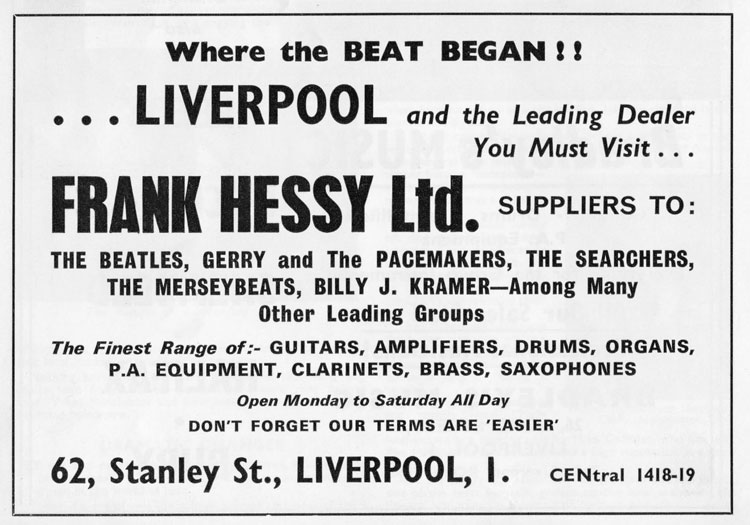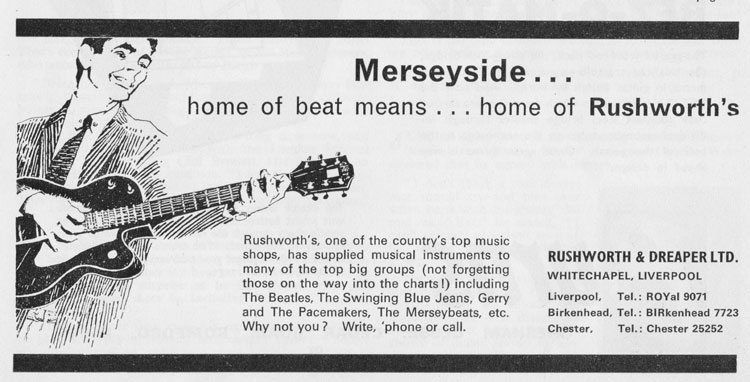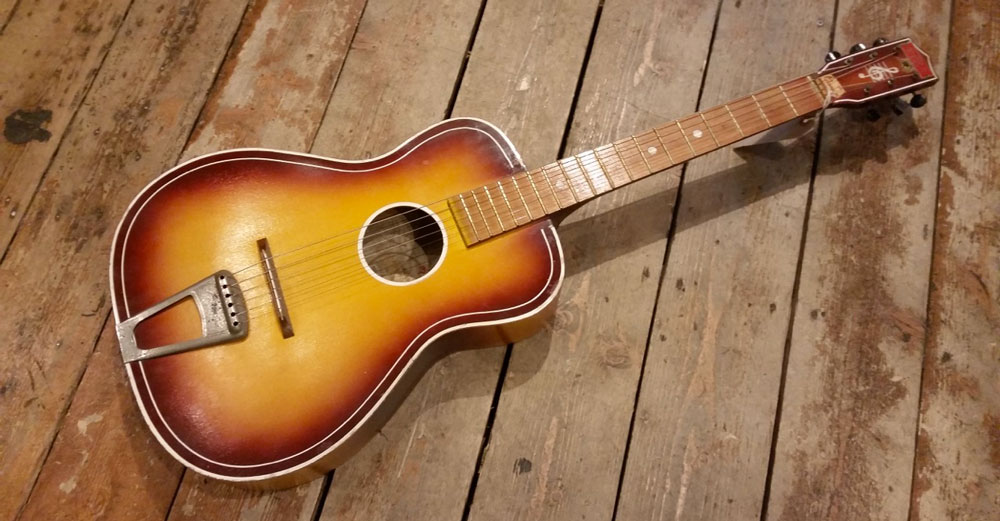New to Reverb? Sign up for free to join the world's best marketplace for music gear. Buy, sell, and discover more about your favorite instruments.
The novelist L.P. Hartley began his novel The Go-Between with the much-quoted line that the past is a foreign country. You wouldn't think so if you come to Liverpool. Its heritage, both maritime and musical, is everywhere. You can visit John Lennon's and Paul McCartney's childhood homes, and you can step into the early '60s as you go into the Casbah or the restored Cavern.
But not everything is being repackaged for today's tourists. Only a couple of hundred yards from the Cavern was Frank Hessy's music store—now covered in scaffolding. Close to that was Rushworth & Dreaper, selling records, tape recorders, and instruments—now a pawnbrokers. Completing a triangle with Hessy's and Rushworth's was Brian Epstein's record store, NEMS—now the site of the new Forever 21 fashion store, and without even a plaque or a sign to indicate that Brian Epstein walked from NEMS to the Cavern on November 9, 1961 to hear The Beatles for the first time. You could trace that famous walk, so why not put footprints on the ground as a tourist attraction?
The Beatles bought instruments at Hessy's and Rushworth's. They heard new US singles they wanted to cover at NEMS. They signed their first management contract at NEMS and Pete Best was sacked there. The locations are so crucial to the Beatles story, and indeed to the whole Merseybeat picture, that 1961–62 could be called The Whitechapel Years. (NEMS and Rushworth's were on Whitechapel while Hessy's was only a few steps from Whitechapel on Stanley Street.)
Because the UK had been ravaged by the Second World War, British teenagers did not have much money in the mid-'50s. That was one reason why skiffle music was an attraction. It was pioneered by Lonnie Donegan ("Rock Island Line") and Chas McDevitt ("Freight Train"), and it encouraged teenagers to form their own skiffle groups, which owed as much to the chandlers as the instrument stores. The teens played cheap acoustic guitars, tea-chest basses, and washboards with thimbles. As they earned more money in their day jobs, they could buy electric instruments and amplifiers, crank up the volume, and play rock'n'roll. They still wouldn't be able to afford them outright but they could sign up and pay by instalments. That was the career path of so many UK bands, and the way The Quarrymen morphed into The Beatles was typical.
Actually, John Lennon's Quarrymen were a little unusual in that they had a drummer, Colin Hanton. Colin has just written Pre:Fab!, a memoir about his time in The Quarrymen. He didn't attend Quarry Bank High School—he had already left his school and had a job, and Eric Griffiths knew he had a drum-kit.

"I used to play on the furniture to jazz records," Colin writes, "and once I was an apprentice upholsterer, my parents said that if I could pay for some drums, I could have them. I went to Frank Hessy's and bought a set of drums for ten shillings down and then ten shillings a week. I think it was £34 in all. I was a drummer, or so I thought. Eric asked if he could hear me play. I set the drums up, put a record on, played along to it, and he said, 'Come down and meet the lads.' I went to Eric's house and that was it. I was a Quarryman."
Frank Hessy belonged to a Russian Jewish family, the Hesselbergs, who came to Liverpool to avoid persecution. Starting in 1923, the family sold musical instruments at Hessy's, which was close to the Mersey Tunnel. Frank, who was born in 1910, didn't open his own shop until 1956, first in Whitechapel and then, four years later, in Stanley Street.
Frank knew there was a market with jazz musicians, and his in-house magazine concentrated on jazz. But also he felt there was a growing teenage market for guitars and drums, and he was prepared to take a chance with the hire purchase (credit) arrangements, usually with the parents acting as guarantors. Frank was highly strung—but who wouldn't be when it was relatively easy to provide false details and walk away with an instrument?

Frank knew intuitively that Jim Gretty would make a fine guitar salesman. Jim worked for the Blood Transfusion Service, but in his spare time he dressed as a cowboy and played country music for club dates. Quite possibly he was the first guitarist that John Lennon saw playing live. John liked to call him Grim Jetty.
Starting in 1956, Jim sold guitars at weekends, but it became a full-time job. He gave instructions to would-be guitarists, showing them how to play "Guitar Boogie," and everyone wanted to learn Jim's so-called "jazz chord." Jim told me, "The guitar was selling left, right, and centre but nobody could play it. I said, 'The best thing to do, Mr. Hessy, is to give free lessons to anyone who buys a guitar.' So I used to get about 30 to 40 people every Monday from six until half past seven. I sold guitars to The Beatles and many other musicians as well."
Rod Davis played banjo in The Quarrymen, and John Lennon's mother Julia taught John to retune and play banjo chords on his first guitar, a cheap Gallotone Champion bought from a mail-order catalogue. John's Aunt Mimi said from time to time, "The guitar's all right, John, but you'll never make your living from it." Why, I wondered, was John allowed a guitar when Mimi frowned upon such things? Eric Griffiths: "I'm not aware that Mimi frowned upon it that much. She frowned upon his dress and his behaviour at school, but I wasn't conscious of her frowning upon him playing the guitar and being in a group."

Paul McCartney had traded the trumpet his dad had given him for a German guitar, a Zenith Model 17, because he could sing and play this instrument at the same time, something that was impossible with a trumpet. Paul joined The Quarrymen shortly after seeing them at St Peter's Garden Fete in Woolton in July 1957, but he missed their first appearance at the Cavern the following month because of his scout camp.
George Harrison was on his second guitar, a Hofner President, by the time he joined The Quarrymen in February 1958. He wanted the band to go electric, but there were financial constraints.
John persuaded Aunt Mimi to act as guarantor for a Hofner Club 40 from Hessy's, and George also had one by swapping his President with Ray Ennis from The Swinging Blue Jeans. When Stuart Sutcliffe sold one of his abstract paintings, he put down a deposit on a Hofner bass with Hessy's and joined The Quarrymen, who were soon renamed The Beatles.
In July 1960, when The Beatles were offered a residency in Hamburg, they were joined by Pete Best, who had bought his Premier drum kit from Rushworth's. Most Merseybeat musicians were violating hire purchase agreements by taking their instruments abroad, something that irritated Frank Hessy—but he knew that with the German income the instalments would now be more likely to be paid.
With import restrictions lifted, local musicians could possess American guitars, and The Remo Four were dubbed Liverpool's Fendermen. Harry Prytherch, the Remo's drummer, told me, "Bob Wooler, who ran the Cavern and could place a lot of work our way, told us that we were very good, but we needed decent instruments. The three guitarists wanted Fenders and I wanted an Ajax drum kit, and we ordered them from Hessy's in 1960. I went into hospital for an operation, and I remember Colin, Don, and Keith coming to visit me with their new guitars. I was looking very ill, with tubes up my nose, and they said, 'We'll bring your drums in tomorrow.' When I came out of hospital, we worked out a fantastic sound, but I was never sure about the green suits. I thought we looked like frogs."
John and George ordered two Gibson J-160E electric-acoustics, which they called their Jumbos, from Rushworth's. They had not been imported to the UK in any great numbers and had to be ordered specially at £160 each. Perhaps sensing the group's growing importance, the store's owner, James Rushworth, was photographed in September 1962 with John and George and their Gibson guitars.
By 1963, there were more than 300 groups on Merseyside alone. It was a nightmare for Frank Hessy as the ownership of the instruments kept changing. Billy Kinsley of The Merseybeats talked about swapping his "little" Burns bass for a bigger Hofner with the bass player from Tommy Quickly & The Challengers. Back home with it, he discovered two six-inch screws holding the neck to the body, but someone told him if he removed those it would fall to bits.
"In early 1963," Kinsley said, "I went into Hessy's and I ordered a Gibson bass. Jackie Lomax had a Gibson bass and I wanted one like his. It was a great bass, but the day I was ordering it, John Lennon walked into Hessy's. He wanted to see Jim Gretty, as he had lost the spring off the Bigsby vibrato arm on his Rickenbacker. In those days, getting spares from America could take months. The only way round it was to persuade Jim Gretty to take one off another guitar, which is what John was hoping for. I told John that I had ordered a Gibson bass, and he said that he and George wanted Paul to have one, but Paul thought the violin bass was the bees' knees."
Frank Hessy retired to Tel Aviv and he died there in 1983. The new managing director was Bernard Michaelson, who had been at Quarry Bank with John Lennon, and the shop closed in 1995. After five generations, the Rushworth family shut their store in 2002, eased out of business by larger competitors.
I can't finish without a reference to Beaver Radio, also on Whitechapel, and equidistant from NEMS, Rushworth's, and Hessy's. The perfect spot. But its owner, Walter Beaver, didn't have the acumen of the other businessmen. In the '50s, he said that stereo would never catch on—people wouldn't want second speakers, and besides, mono was just as good. Then, in the '70s, he said that video would never take hold, as there were already too many repeats on TV. Finally, in the mid '80s, he came down against CDs, saying that the public would never want to buy their records over again. Frank Hessy was far more prescient, having anticipated the rush for acoustic guitars as the skiffle boom got under way in 1956. I think Walter Beaver would have got on well with Aunt Mimi.
New to Reverb? Sign up for free to join the world's best marketplace for music gear. Buy, sell, and discover more about your favorite instruments.
About the Author: Spencer Leigh was born in Liverpool in 1945 and his On The Beat show has been running on BBC Radio Merseyside for over 30 years. He wrote The Beatles In Liverpool (Omnibus Press / Chicago Review), and also The Cavern Club (a day-to-day history), Love Me Do To Love Me Don't (The Beatles on record), and Best Of The Beatles (the sacking of Pete Best), all for McNidder & Grace. He worked with Hunter Davies on The Beatles Book (Ebury).
